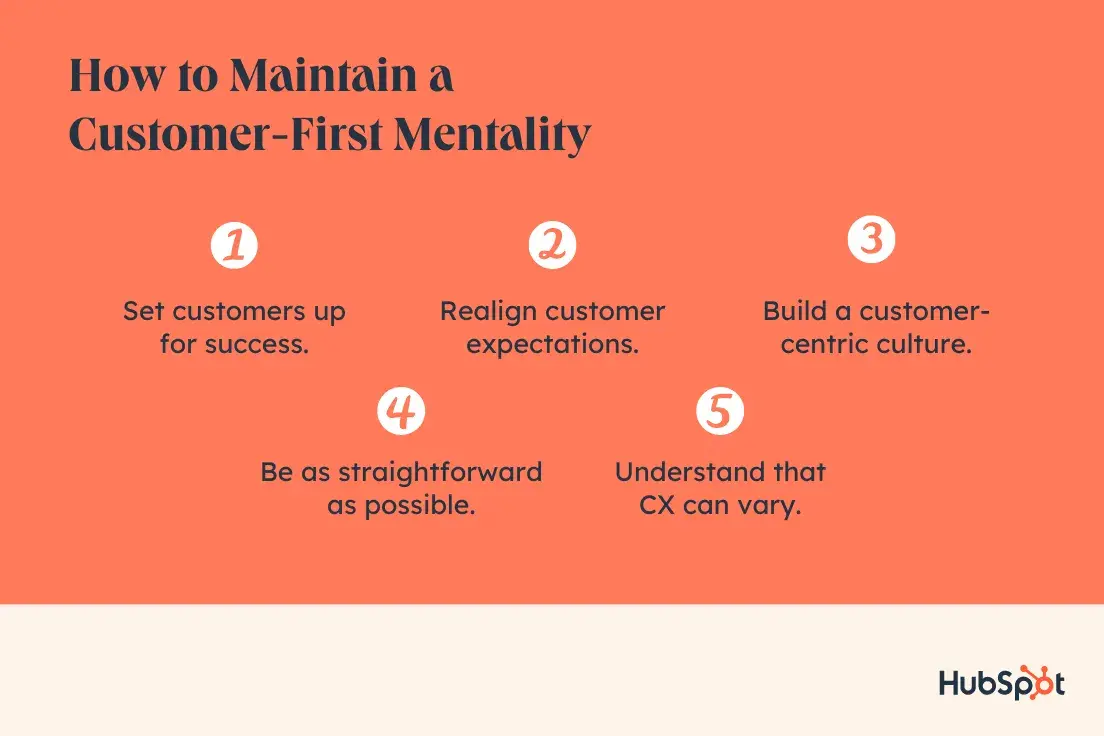But that doesn’t mean the phrase “the customer is always right” doesn’t hold any merit. In this piece, I’ll discuss how this philosophy should (and shouldn’t) factor into your customer service strategy, along with inputs from customer-centric professionals.
Continue reading or jump ahead:
Is the customer always right?
The short answer is no, but it’s important to remember that customer satisfaction is your ultimate goal. The phrase ‘the customer is always right’ shouldn’t imply that the customer is never wrong. Instead, your business should use this philosophy to ensure that the customer — and their needs — are always your first priority.
What does “the customer is always right” mean?
While ‘always right’ usually translates to “never wrong,” this isn’t necessarily the case when it comes to customer service.
Customers aren’t going to be right in every situation, but they are entitled to have support and service teams do everything in their power (within reason) to satisfy their needs.
Here’s an interesting video that offers more perspective on this age-old question.
Origin of ‘The Customer Is Always Right’
This concept originated in 1893 and was first adopted by retailers who believed that business success relied on customer happiness. It was later introduced in the hospitality industry, where it became the early standard for customer service.
Who came up with ‘the customer is always right’?
Marshall Field first introduced the concept when he founded Chicago's first department store, Marshall Field’s, in 1893.
Overseas, Henry Gordon Selfridge followed suit when he opened the first department store in London.
Almost 100 years later, César Ritz introduced the motto to the hospitality industry when he founded The Ritz Carlton Hotels.
His mantra was “Le client n'a jamais tort,” which means the customer is never wrong.

In all cases, these pioneers instructed their employees to give priority to customer satisfaction, no questions asked.
Although it was a novel idea at the time, their strategy worked. Customers were not used to being treated with that level of care, and they flocked to both these businesses in response.
Subscribing to the mindset that the customer is always right means that businesses shouldn't spend time questioning the legitimacy of customer complaints.
Instead, employees focus their energy on troubleshooting issues and delighting customers with solutions.
In my opinion, when you think of “the customer is always right,” don’t think of it in the context of “customers can do no wrong.”
Here are five reasons why this phrase should hold true.
1. The customer always has the right to have their voice heard.
Customers want to feel like you’re actively listening to their pain points and concerns. That’s why even the angriest of customers deserve to feel seen and heard by a business.
You should always give your customer the platform to share their opinions — both the positive and the negative. Customer feedback surveys are a great way to make this happen.
2. The customer always deserves to have their issues resolved.
Your job is to provide a seamless experience for your customers. If there’s too much friction throughout the customer journey, those customers are more likely to churn.
You should always strive to resolve customer issues quickly and effectively. Customer journey mapping can help you proactively mitigate these issues along the way.
3. The customer always has the privilege to feel empowered.
Empowered customers are happy customers. Happy customers are loyal customers. And loyal customers are most likely to stick around and promote your business to others.
You should always create an environment where customers feel comfortable using your products on their own. Knowledge bases and FAQs are two solid places to start.
4. The customer always deserves to be treated with dignity and professionalism.
Basic values go a long way. A quote by the American poet Maya Angelou comes to my mind, “I've learned that people will forget what you said, people will forget what you did, but people will never forget how you made them feel.”
Customer interactions are no different. It’s important to maintain a professional demeanor throughout, even with tough customers.
5. The customer has the right to expect consistent and timely support.
Imagine you send a complaint via email to two businesses. One responds within an hour and solves your issue, while the other takes over four days to get back to you. Which one would leave you feeling satisfied?
I know which one I’d purchase from again.
82% of customers expect immediate problem resolution from customer service agents.
Customer service software, such as HubSpot’s Service Hub, can help businesses by providing a platform to manage customer support and service interactions smoothly.
What To Do When the Customer Isn’t Right
It’s natural to have situations arise where the customer isn’t right, yet they feel they are. So, how do you handle such scenarios?
I spoke to four customer-centric leaders, and this is the advice they offered.
1. Understand the “why” behind the customer complaint or request.
Sidharth Ramsinghaney, Director of Corporate Strategy and Operations at Twilio, highlights the importance of uncovering the deeper reasons behind a customer’s request. He shares an example of working with a telecommunications client whose preferred solution initially seemed suboptimal. Instead of dismissing their stance, his team discovered that confidential business model changes and regulatory requirements drove the client’s position.
Ramsinghaney explains that by building trust and showing curiosity, they co-created a solution that addressed both immediate technical needs and future constraints.
“Success in these situations comes from reframing the conversation from ‘right versus wrong’ to ‘good versus better,’” he says. “When we truly understand the context behind a customer’s perspective - whether it‘s internal pressures, resource constraints, or undisclosed strategic shifts — we often find they’re not wrong, just operating within a different set of parameters.”
His advice? “The art lies in becoming a trusted thought partner who can navigate these nuanced constraints to find an optimal path forward.”
2. Use the “Acknowledge, Relate, Offer” method.
Lasandra Barksdale, Founder & Principal at Kompass Customer Solutions LLC, says that, in customer-centric roles, “the golden rule to follow when the customer isn‘t right is to lead with clarity, not conflict.” Customers often bring misinformation, unrealistic expectations, or demands that go against your company’s values or policies. Instead of mirroring their frustration, you can guide them toward the right solutions.
Barksdale shares an example: Imagine a hotel guest demanding a refund for rain ruining their vacation. Is it the hotel’s fault? Absolutely not. But a thoughtful response can turn frustration into loyalty.
“I train customer-facing teams on my A.R.O. Method (Acknowledge, Relate, Offer), which is a modern twist on the classic “feel, felt, found” approach,” she says. Here's how it might sound in action:
- Acknowledge: “I completely understand how disappointing it can be when weather affects your plans.”
- Relate: “Honestly, I had a similar experience myself when visiting Panama City. Imagine being disappointed about rain in a rainforest when rain is practically guaranteed!”
- Offer: “While we can’t control the weather, we’d love to make it right for you. How about a complimentary upgrade?”
“Of course, even this approach may not satisfy every customer, but saying ‘no’ isn’t the opposite of being customer-centric. Sometimes, the best service you can provide is guidance, not compliance,” Barksdale adds. “Customers don’t always want to win, but they do want to feel heard. By respectfully steering the interaction, you can turn moments of frustration into opportunities to strengthen the relationship.”
3. Set better boundaries and prepare your team for these situations.
Mark Levy, Publisher of the DCX Newsletter that provides inspiration, education, and coaching for customer-obsessed leaders, says, “I once had a customer demand we change a policy just for them. They weren’t just asking — they were furious about it. My team was stressed, unsure how to respond without causing a scene.” Sound familiar?
Here’s the deal: not every request is fair, and trying to please everyone is exhausting. It drains your team and sets a bad precedent.
So what do you do? “Start with empathy — acknowledge the issue and let the customer feel heard. But then set boundaries,” Levy recommends. “Teach your team to say something like, ‘I get where you’re coming from, and here’s what we can do.’”
Prep your team for these moments. Run role-plays during meetings — it’s awkward but worth it. And create a cheat sheet for handling tough situations, so they’re never caught off guard.
“Backing your team while handling tricky customers isn’t easy, but it works,” he adds. “Happy employees handle tough calls better, and that benefits everyone. Trust me, your sanity will thank you.”
4. Practice deep listening, then educate and focus on solutions.
Stijn Smet, head of customer success at Whale and the Founder of the Customer Success Hotline, says, "Let’s face it: the customer can be wrong. But how do we handle that? That’s where the magic happens.”
“Start by deeply listening,” he recommends. “Often, the ‘wrong’ stems from misaligned expectations or misunderstanding. Dig into their perspective and validate their concerns: ‘I hear you, and I understand why this feels frustrating.’ This shows respect and diffuses tension.”
Next, educate with confidence. Be clear and bold in explaining why their request isn’t feasible or aligned. “Here’s how this approach benefits you in the long run.” You’re not shutting them down; you’re empowering them with knowledge.
Finally, shift the focus to solutions. Can you offer an alternative? A workaround? By reframing the conversation toward value, you keep the trust intact — even when saying “no.”
“Handling tough moments with bold empathy and a focus on partnership transforms challenges into growth opportunities — for the customer and for you,” Smet says.
How to Maintain a Customer-First Mentality
The “customer is always right” way of thinking is all about the customer-first mentality.
I’ve noted down a few ways you can lead with this mindset at your business.

Set customers up for success.
I believe strongly that customer interactions shouldn’t revolve around who is right and who is wrong.
Instead, reps should center the conversation around guiding customers down the best path to success and showing them allyship.
In practice, this looks like:
- Sympathizing with customer pain points.
- Redirecting the conversation toward more achievable solutions.
- Acknowledging the customer's frustrations.
- Reaffirming that you're on their team.
- Offering up something you can solve.
For example: “I understand that you're not seeing the results you want here — I know that can be really frustrating. However, I really think we should consider X as an alternative solution.”
Realign customer expectations.
Customers can sometimes have unrealistic expectations about how a product works.
These misunderstandings can lead them to become frustrated because they feel like your product isn’t meeting their needs.
I feel that it’s important to make sure the customer has full knowledge about how a product is intended to operate and how they can make it work for them.
In practice, this looks like:
- Zooming out on the goal to ensure everyone's working together.
- Helping customers understand what they need to change to ensure their expectations are met.
For example: “It looks like you’re having trouble with our analytics tool. Can you clarify what you’re hoping to gain? Then we can figure out where the disconnect may be.”
Build a customer-centric culture.
Even if a customer is technically not correct, maintaining a customer-centric culture is crucial.
There are going to be times when the customer isn’t right, but it’s still important to understand where they are coming from.
In practice, this looks like:
- Aligning with them during customer calls.
- Provide insight and concrete action items you can take together.
- Putting their needs first regardless of right or wrong.
For example: “I understand you’re frustrated about this issue, and it’s not your fault. It’s us against the issue — let’s start with X so we can tackle this together.”
Be as straightforward as possible.
Dissatisfaction can sometimes stem from confusion.
A customer may not understand how to use a product, and their confusion can lead them to believe that it’s malfunctioning.
Situations like this require extreme clarity.
In practice, this looks like:
- Confirming whether or not the customer understands what’s going wrong.
- Taking the time to provide in-depth insights for the customer.
- Sharing helpful information and resources for further education.
For example: “I found this topic confusing at first, too, but this article was really helpful for me. If that doesn’t help, I have a couple of other resources we can try.”
Understand that customer experiences can vary.
Customers have a right to voice their thoughts, ideas, and opinions about whatever is frustrating them.
And in most cases, the customer has one idea based on their individual experience that is very real to them. It’s important to acknowledge that.
In practice, this looks like:
- Recognizing that each customer experience is real and valid.
- Actively listening to the specific issue or situation at hand.
- Not directly comparing one customer’s journey to another.
For example: “I see where you’re coming from, and you’re making some really good points. It sounds like X might make the most sense for you moving forward.”
The Bottom Line
I’ve learned that there likely will always be a never-ending debate over the ‘customer is always right’ strategy. But, in my opinion, it's a balance between taking time to understand customers’ issues and providing them with solutions that will bring the most success.
What was true for early retail pioneers is still true now: customer retention revolves around solving customer issues, even if they aren't always right.
Editor's note: This article was originally published in October 2020 and has since been updated for comprehensiveness.
Customer Experience












![14 Best Practices for B2B Customer Experience [New Data]](https://53.fs1.hubspotusercontent-na1.net/hubfs/53/b2b-customer-experience_2.webp)